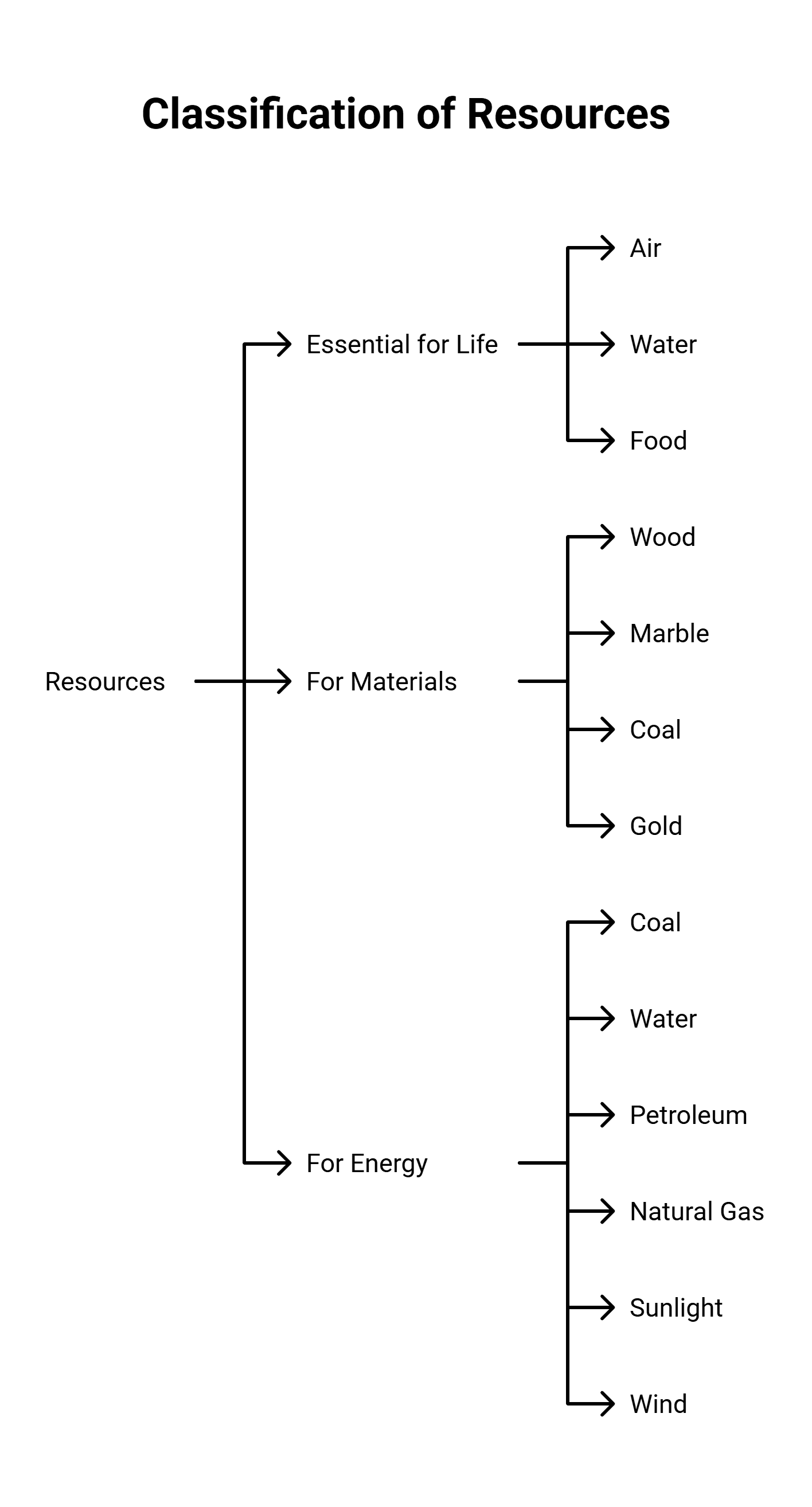Natural Resources and Their Use Chapter Notes | Social Science Class 8 - New NCERT PDF Download

Introduction
Have you ever wondered where the water you drink, the food you eat, and the things you use every day come from?
They all begin with nature! Everything we use—water, food, and materials—comes from nature. But these things only become resources when we know how to use them.
 Dudhsagar Waterfall and Railway Bridge Goa
Dudhsagar Waterfall and Railway Bridge Goa
In this chapter, you’ll learn:
- What natural resources are
- The difference between renewable and non-renewable resources
- Why using resources wisely is important for our future
Let’s discover how we can protect and use India’s natural gifts in a smart way!
When does Nature become a Resource?
Nature includes all living things (plants, animals) and non-living things (water, air, minerals) in our environment that are not made by humans. Example: Trees, rivers, and coal occur naturally and are not man-made.
How Nature Becomes a Resource:
- When humans use elements from nature for living or making things, they become resources.
- Examples:
Cutting trees for furniture makes them a resource.
Using water for drinking or farming makes it a resource.
 Resources
Resources
Did You Know?
In many indigenous traditions around the world, Nature is considered sacred — seen as both a nurturer and a nourisher. These cultures often have unique practices that honor and protect the environment.
Conditions for a Resource:
- Technologically Accessible: We need tools or technology to use it (e.g., machines to drill for oil).
- Economically Feasible: It shouldn’t cost too much to get or use (e.g., mining coal affordably).
- Culturally Acceptable: It must respect beliefs (e.g., not cutting trees in sacred groves).

Some Important Natural Resources
- Obvious Resources: Water, air, and soil, used for drinking, breathing, and farming.
- Less Obvious Resources: Coal, petroleum, precious stones, metal ores (like iron), and timber.
- Many formed over millions of years, like coal and oil.
Meaning of ‘Exploitation’:
- Usually, the word “exploitation” sounds like using something in a bad or unfair way. But, in this chapter, it simply means taking, using, and consuming natural resources.
- Example: When we cut wood, which comes from trees in forests, we are using a natural resource to build something useful—like houses.
Categories of Natural Resources
Categorizing resources helps in understanding and communicating their significance effectively. There are two primary ways to categorize natural resources: based on their use and based on their renewability.
1. Based on Use
Resources can be classified according to their role in human life, such as essential for life, materials, and energy sources.

Resources Essential for Life:
- Include air, water, and food, without which life cannot exist.
- Sourced from the atmosphere (air), rivers/ponds (water), and soil/living organisms (food).
- Humans cannot create these resources; they are provided by nature.
Resources for Materials:
- Used to create physical objects for utility or beauty (e.g., wood for chairs, marble for sculptures).
- India’s geographical diversity provides varied resources like wood, marble, coal, and gold.
Resources for Energy:
- Essential for modern living, powering buildings, transportation, and industries.
- Sources include coal, water, petroleum, natural gas, sunlight, and wind.
2. Based on Renewability:
Renewable and Non-Renewable Resources
Natural resources can be divided into renewable and non-renewable types based on whether they can regrow or not.

Nature’s Restorative and Regenerative Ways:
- Nature heals itself through restoration, like a cut on your skin healing or a forest recovering after a fire.
- Regeneration creates new life, like new trees growing in a forest. A fallen tree decomposes, enriches soil, and helps new plants grow.
- When humans clear forests for things like building houses, trees are lost and the natural balance is disturbed. Planting the same kinds of trees that originally grew there helps restore the ecosystem.
- These trees provide food and shelter for animals like birds and squirrels, allowing life to come back.
- Nature works in cycles where nothing is wasted. For example, when a tree falls in a forest, bacteria, fungi, and insects break it down into nutrients that enrich the soil.
- New plants and trees then grow from seeds, continuing the cycle over and over. This shows how nature restores and regenerates itself naturally.
What Are Renewable Resources?
Renewable resources can be replenished or renewed naturally in a short period. They include unlimited resources like solar and wind energy. However, careless use can impact their availability. For instance, despite being renewable, water sources are drying up in some parts of the world.
Examples:
- Solar energy
- Wind energy
- Forests

Characteristics of Renewable Resources
- These resources continue to be available as long as nature’s natural cycles are maintained.
- Rivers depend on continuous input from rainfall and glacier melt to remain flowing.
- Forests can provide timber for a long time if trees are allowed to grow back after harvesting.
- Soil nutrients are restored naturally through ecosystem processes.
- Solar and wind power are constantly available through natural phenomena.
Conditions for Sustainability
- Renewable resources remain renewable only if the natural rhythm of restoration and regeneration is not disturbed.
- If we use resources faster than they can regenerate, the resource can become depleted.
- Example: If timber is harvested faster than forests can grow new trees, the forest will be lost.
 Pollution by Industries
Pollution by Industries
Human Impact and Challenges
- Scientists have found that many natural cycles are being disturbed due to irresponsible human actions. Two main factors causing disturbances:
- Industrialization powered by fossil fuels
- Deforestation for agriculture and other purposes
- These factors have led to rising global temperatures and climate change.
- Due to global warming, glaciers in the Himalayas are melting faster than snowfall and precipitation can replenish them.
Did you know?
In the past, communities stopped fishing during fish spawning season to help fish populations grow. But with commercial fishing, over-fishing happened. For example, tuna numbers have dropped quickly. Tuna is important because it keeps the ocean balanced by eating smaller fish and shrimp.
Implications of Disturbances
- Melting glaciers threaten water security for people living downstream in the plains who depend on glacier-fed rivers—often called the ‘water towers’.
- Pollution and unsustainable use can harm ecosystems and human health.
- Unchecked exploitation and pollution of renewable resources lead to serious environmental problems.
Ecosystem Services
- Nature works in special ways called ecosystem functions, like trees making oxygen, cleaning water, and protecting soil. When these natural actions help people, we call them ecosystem services.
For example, one mature tree produces about 275 litres of oxygen daily, while a person needs around 350 litres of oxygen every day to breathe.
What Are Non-Renewable Resources?
Non-renewable resources are natural resources that form over very long periods and cannot be replenished quickly enough to keep up with the rate at which we use them.
Examples:
- Fossil fuels such as coal and petroleum.
- Minerals and metals like iron, copper, and gold.

Coal in India:
- India has large coal reserves, which are mined to meet increasing energy demands.
- However, these coal reserves are limited and may last for only about 50 more years at the current rate of use.
- Growing Energy Needs: As India's population grows and development accelerates, electricity demand is increasing, putting more pressure on coal use.
- Sustainable Use: Until cleaner and more sustainable energy sources become widely available, it is important to use coal and other non-renewable resources carefully and wisely to avoid rapid depletion.
Distribution of Natural Resources and Its Implications
Natural resources like water, coal, and minerals are unevenly distributed across the world. This shapes where people live, how trade develops, and can even lead to conflicts.

Uneven Distribution of Resources:
- Resources are not found equally everywhere on Earth or in countries.
- Some areas have more resources (e.g., coal in Jharkhand), while others have less.
- Example: Oil is abundant in some countries but scarce in others.
Impact on Human Life:
- People settle near resources for jobs and better living.
- Industries near resources create jobs and build towns with modern facilities.
- Example: Mining towns grow near coal mines, providing schools and hospitals.
 Shared waters of the Brahmaputra river
Shared waters of the Brahmaputra river
Benefits of Resource-Rich Areas:
- Jobs from industries like mining or oil extraction.
- Economic growth from trade, like selling minerals or crops.
- Improved quality of life with better facilities, like roads and electricity.
Costs and Challenges:
- People may be forced to leave their homes for mining or factories.
- Sacred places, like forests or temples, can be damaged, causing conflicts.
- Example: Some communities lose their land to big projects, leading to protests.
Trade and Economic Growth:
- Resources combined with skills create valuable products, like India’s Wootz steel.
- Trade of these products helped build large empires in India long ago.
- Example: Selling Wootz steel to other countries made India wealthy.
 Mettur Dam on Kaveri River
Mettur Dam on Kaveri River
Conflicts Over Resources:
- Resources don’t follow political borders, causing disputes between states or countries.
- Example: Kaveri River water sharing among Karnataka, Tamil Nadu, Kerala, and Puducherry leads to tensions.
- Negotiations and fair management are needed to keep peace.
The Natural Resource Curse
The Natural Resource Curse, or Paradox of Plenty, happens when countries with many natural resources, like coal or oil, grow slowly or stay poor because they sell raw materials instead of making valuable products.
 Natural Resources
Natural Resources
What is the Natural Resource Curse?:
- Countries with many resources may not become rich.
- They grow slowly because they focus on selling raw materials (e.g., coal, minerals) instead of making products (e.g., steel, machines).
- Example: Selling raw cotton gives less money than making clothes from it.
Why Does It Happen?:
- Countries rely too much on selling raw resources.
- They don’t build factories or train people to make high-value products.
- This leads to short-term money (temporary windfalls) but not long-term growth.
India’s Success:
- India avoids the curse by building industries (e.g., using coal to make electricity or steel).
- These industries create jobs and help the economy grow.
- Example: India’s steel factories use local iron ore to make products, not just sell the ore.
Challenges:
- Using resources without wasting them or harming nature.
- Ensuring resources last for future generations (sustainability).
How to Avoid the Curse:
- Human Knowledge: Train people to use resources smartly.
- Good Governance: Make fair rules for resource use.
- Strategic Planning: Plan for long-term growth, not just quick money.
Responsible and Wise Use of Resources: Stewardship
To keep our planet healthy, we must respect nature and use its resources wisely.
- This means helping renewable resources (like water and soil) restore and regrow naturally, and using non-renewable resources (like coal and cement) carefully so they last longer.
- Scientists warn that misusing resources causes problems like pollution, loss of plants and animals (biodiversity loss), and climate change, which are getting worse quickly.
Restoration and Regeneration of Renewable Resources
Renewable resources, like water and soil, can regrow or refill naturally if we handle them well. We must use them carefully to help nature’s cycles continue.Here are two examples of how we are pushing the use of natural resources beyond their capacity to regenerate:
1. Groundwater Overuse
Farmers use groundwater to water crops, but in many places, they take out more water than nature can replace. This lowers the water table (underground water level), Common practices like rainwater harvesting, reviving ponds, and reusing water help solve this problem.

2. Soil Degradation
Using too many chemical fertilizers and pesticides harms soil, making it less fertile. Traditional practices respected soil as part of nature and used natural methods to keep it healthy.
Traditional Soil Care Methods:
- Using cow dung and natural fertilizers.
- Mulching (covering soil to keep it moist).
- Multi-cropping (growing different crops together to enrich soil).
Need: We must adopt these practices to restore and rejuvenate soil.
Overexploitation of groundwater: a caselet from Punjab
In the 1960s, Punjab’s farmers started growing high-yielding crops needing more water, leading to heavy groundwater use.
- Free electricity encouraged over-pumping, lowering water tables to ~30 meters deep in 80% of Punjab, marked as “overexploited.”
- Chemicals from fertilizers and pesticides mixed into groundwater, causing health risks.
- This ensured food security in the short term but harmed long-term sustainability.
The Case of Cement
Cement is essential for buildings, roads, and bridges, but making it pollutes a lot. The dust from cement factories harms lungs, reduces plant growth, and pollutes soil and water. Efforts are being made to reduce this pollution. Jaisalmer Fort
Jaisalmer Fort
- The Central Pollution Control Board has created guidelines for cement factories to ensure that the pollution is minimised or eliminated.
- Using sustainable materials like stone, mud, plant-based materials, and recycled plastic.
- Example: Auroville’s mud-based buildings and Jaisalmer Fort’s mud structure, later refurbished using sandstone, combine traditional and modern methods to reduce pollution.
Vṛikṣhāyurveda: The Ancient Indian Science of Plant Care
Vṛikṣhāyurveda combines two Sanskrit words: vṛikṣha (tree) and ayurveda (the science of life or health). It is an ancient botanical science focused on the study, care, and health of plants and trees. This traditional knowledge system dates back thousands of years and was formalized in texts like Surapala’s Vṛikṣhāyurveda around the 10th century CE.
Key Aspects:
- Plant-Soil Relationship: Advises which plants grow best on specific soil types.
- Seed Management: Details how to collect, preserve, and prepare seeds before planting.
- Irrigation Practices: Describes watering methods tailored to different plants, their growth stages, and seasonal needs.
- Pest Control: Recommends natural pest repellents and companion planting (growing certain plants together to protect each other).
- Sustainable Agriculture: Promotes crop rotation and mixed cropping to keep soil healthy and fertile.
- Soil Care: Suggests proper ploughing techniques to conserve soil moisture and support beneficial soil organisms like fungi, bacteria, and earthworms.
Overall Importance:
Vṛikṣhāyurveda advocates natural, eco-friendly farming and gardening methods that maintain and improve soil and plant health sustainably, reflecting deep ecological wisdom from ancient India.
A caselet from Sikkim
Pema’s family farm in Sikkim faced low crop yields and debts from costly chemical fertilizers. They switched to organic farming, which was hard at first but led to success. The family switched to compost, prepared natural pest repellents using neem and garlic, and started growing multiple crops across the year. After about five years, Pema’s farm was thriving.
 Organic Farming in Sikkim
Organic Farming in Sikkim
Sikkim’s Organic Journey:
In 2016, Sikkim became 100% organic, boosting:
- Biodiversity - more insects and birds returned.
- Tourism - visitors came to see organic farming.
- Farmers’ incomes- (up by 20% on average).
- Sikkim is now a global model for sustainable farming.
Responsible and judicious use of resources
Non-renewable resources, like coal and cement, cannot be replaced quickly. We must use them carefully to make them last until we find sustainable alternatives. So, we need to make the switch to renewable sources of energy for as many purposes as we can.
 Satellite image of one of the largest solar parks in the world located in Rajasthan
Satellite image of one of the largest solar parks in the world located in Rajasthan
Example: Rajasthan’s Bhadla Solar Park:
- One of the world’s largest solar parks.
- Produces enough electricity for ~15% of Rajasthan’s needs.
- Shows how switching to solar energy helps save non-renewable resources.
The International Solar Alliance (ISA): India’s Leadership in Renewable Energy
The International Solar Alliance is a group of countries that get lots of sunlight. It was launched in 2015 by India and France. The aim is for these sunshine-rich nations to work together to use solar power for a cleaner, greener future.
 Solar Farm- Karnataka
Solar Farm- Karnataka
Why was ISA created?
- To bring together countries with plenty of sunshine.
- To encourage the use of solar energy, instead of polluting fossil fuels.
- To help countries share technology, ideas, and resources for solar projects.
India’s Role:
- India is a leader and founding member of ISA.
- It has helped raise billions of dollars for solar projects in developing countries.
- India shares its technical know-how and creates affordable ways for other countries to get solar technology.
- The Bhadla Solar Park in Rajasthan is one of the world’s largest solar parks and shows how India is switching from coal and oil to clean solar energy.
Importance for India and the World:
- Environmental Responsibility: Using solar power reduces pollution and protects the environment.
- Economic Opportunity: Solar power can create jobs, provide cheaper, reliable electricity, and reduce the dependence on expensive imports like oil.
Fair Access to Resources
- Not everyone gets equal access to resources like clean water and air.
- In cities, some areas lack regular water supply, and air pollution from industries and fossil fuels harms those who can’t protect themselves.
- We need to act as stewards—caretakers of nature—by protecting resources and ensuring everyone has fair access to things like clean water and air.
- The Bhagavad Gita teaches lokasangraha, which means working for the good of all, not just ourselves. This idea encourages us to use resources thoughtfully for a better future.
Key Points to Remember
- Natural Resources: Natural resources are materials/substances from nature valuable to humans, requiring technological, economic, and cultural feasibility.
Categories:
By use: Essential for life (air, water, food), materials (wood, marble), energy (coal, solar).
By renewability: Renewable (solar, wind, timber), non-renewable (coal, petroleum).- Nature’s Cycles: Restoration (healing) and regeneration (new life) ensure no waste, but human actions like overfishing and industrialization disrupt these.
- Distribution: Uneven, influencing settlements, trade, and conflicts; can lead to the “natural resource curse” without proper management.
- Stewardship: Responsible use involves sustainable practices, traditional knowledge (e.g., Vṛkṣāyurveda), and modern initiatives (e.g., Sikkim’s organic farming, ISA).
- Challenges: Pollution, biodiversity loss, and resource depletion require urgent action.
- Solutions: Reduce/reuse/recycle, adopt renewable energy, and revive traditional practices for soil and water management.
|
28 videos|113 docs|7 tests
|
FAQs on Natural Resources and Their Use Chapter Notes - Social Science Class 8 - New NCERT
| 1. What defines the transition of nature into a resource? |  |
| 2. What are the main categories of natural resources? |  |
| 3. How does the distribution of natural resources affect a country's economy? |  |
| 4. What is the natural resource curse, and how does it manifest? |  |
| 5. Why is responsible use of natural resources important? |  |


















